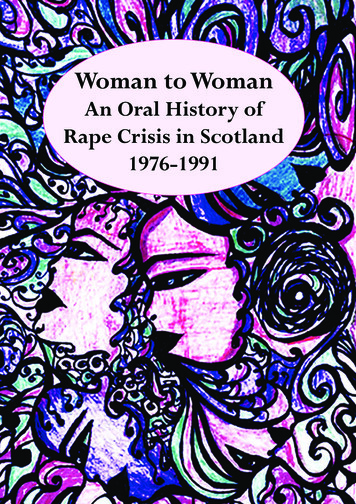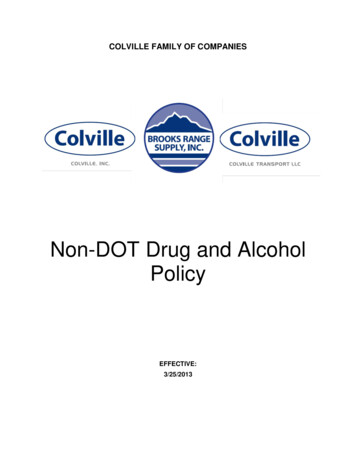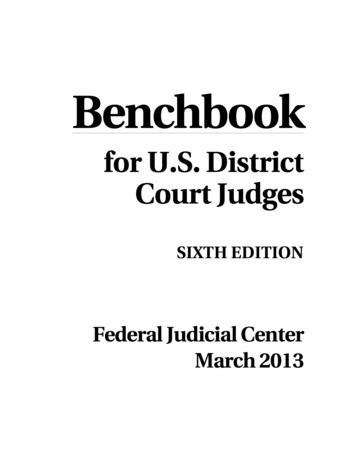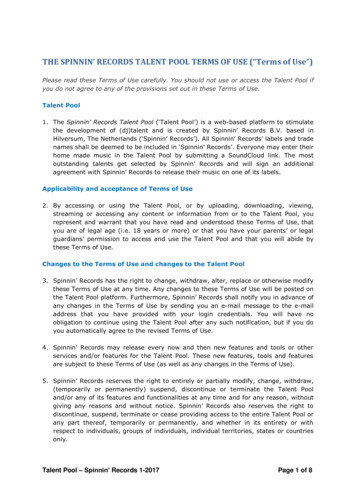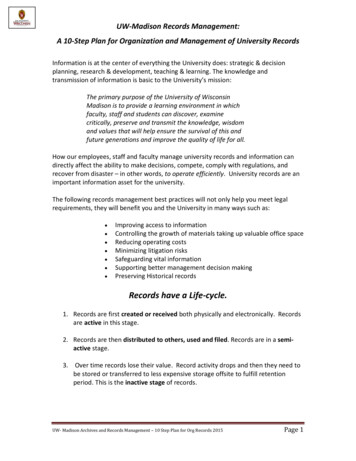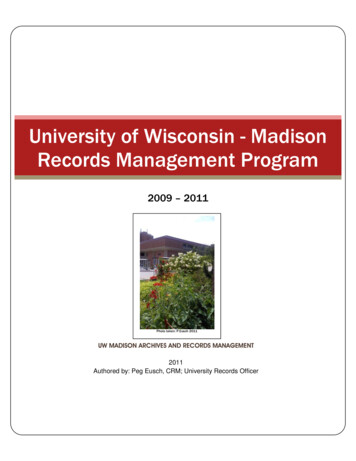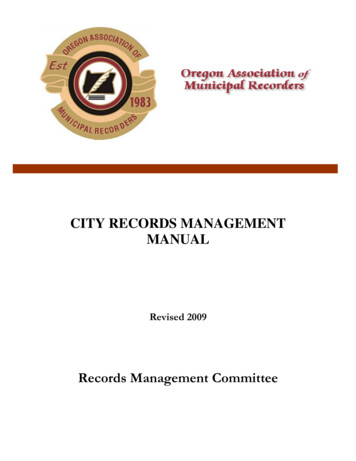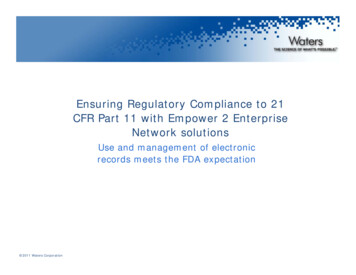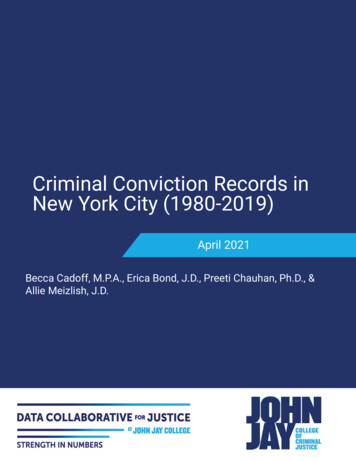
Transcription
Criminal Conviction Records inNew York City (1980-2019)April 2021Becca Cadoff, M.P.A., Erica Bond, J.D., Preeti Chauhan, Ph.D., &Allie Meizlish, J.D.
Table of ContentsPageKey Findings1Introduction3The Consequences of Criminal Convictions3Legal Landscape: Sealing and Expungement6Background: Trends in Arrests7I. Trends in Criminal Convictions10Convictions by Charge Category11Criminal Conviction Records by Demographic Categories16II. Demographics of Individuals with Criminal Conviction Records20Race and Ethnicity of Individuals with Criminal Conviction Records20Sex of Individuals with Criminal Conviction Records22Current Age of Individuals with Criminal Conviction Records24III. Characteristics of Criminal Conviction Records26Number of Convictions26Time Since Most Recent Conviction28Volume and Types of Convictions by Charge 37Appendix A: Data and Methods39Appendix B: Additional Resources on Consequences of Convictions42Appendix C: Law Codes by Charge44Appendix D: New York City Population Data61Appendix E: Additional Analyses62The Data Collaborative for Justice (DCJ) at John Jay College of Criminal Justice houses a group of researchinitiatives that raise important questions and share critical research about the criminal justice system andits role in creating safe, just, and equitable communities. DCJ conducts data analysis and research onenforcement in the community, the adjudication of cases in the courts, and the use of confinement in jailsand prisons. DCJ’s work has informed policy reforms, facilitated partnerships between researchers andgovernment agencies across the country, spurred new scholarly research on lower-level enforcement, andhas been cited extensively in the press. For more information about the Data Collaborative for Justice pleasevisit: https://datacollaborativeforjustice.org/Data Collaborative for Justice
Criminal Conviction Recordsin New York City (1980-2019)April 2021KEY FINDINGSAccumulation of Convictions in New York Cityy Volume of Convictions: Between 1980 and 2019, there were 10,884,240 arrests in New YorkCity, which resulted in 3,354,166 criminal convictions for 745,924 individuals.y Convictions by Severity and Charge Category: Of the 3,354,166 convictions that haveaccumulated since 1980, 77.8% (2,575,639) were misdemeanor convictions and 23.2%(778,527) were felony convictions.» Misdemeanor Convictions: The most common charge categories for misdemeanorconvictions were “other” charges (e.g., turnstile jumping, loitering, and prostitution),which made up 34.8% of all misdemeanor convictions, followed by drug charges (saleand possession) at 29.9%, and property-related charges at 26.9%. (See page 11 for thevarious charge categories and definitions)» Felony Convictions: The most common charge categories for felony convictions weredrug charges (sale and possession), which made up 43.5% of all felony convictions,followed by person-related convictions at 25.7%.» Drug Convictions: 33.1% of all misdemeanor and felony convictions (1,108,209convictions) were for drug charges (sale and possession).y Convictions by Race: Of the 2,517,965 convictions between 1990 (the first year for which racedata is reliable) and 2019, 86.6% were of Black (53.9%) and Latinx individuals (32.7%).People with Criminal Conviction Records in New York Cityy Charge Severity: Between 1980 and 2019, 745,924 individuals were convicted of felony ormisdemeanor charges in New York City.y Race/Age/Sex: Individuals with a criminal conviction record were predominantly Black (42.4%)or Latinx (36.9%), male (84.3%), and over 45 years old (68.7%).y Number of Convictions: 42.2% of individuals with a criminal conviction record had only oneconviction (62.2% of which were for a misdmeanor conviction) and 16.1% of individuals hadonly two convictions.y Time Since Most Recent Conviction: Of individuals with criminal conviction records, almosttwo- thirds (63.9%) have not been convicted of a new crime in the last 10 years.y Most Prevalent Charge Convictions: Of individuals with criminal conviction records, 14.9%(111,328 people) had only drug-related convictions (one or more) on their records. Further,6.2% (46,326 people) had only drug possession convictions (one or more) on their convictionrecords.Data Collaborative for Justice1
Data Collaborative for Justice2
IntroductionBetween 1980 and 2019, the police made just under 11 million arrests in New York City. In recent years,there has been a significant focus on identifying patterns in these arrests, including patterns in whois arrested (e.g., the majority of arrests were of Black and Latinx1 individuals) and fluctuations in theseverity and category of charges.2 However, less attention has been paid to the legacy of these arrests,including how many of these arrests resulted in convictions that left an individual with a permanentcriminal record – a record that can impact employment, education, housing, and immigration status.In this report, the Data Collaborative for Justice (DCJ) presents analyses on criminal convictionrecords in New York City from 1980 through 2019 using data provided by the New York State Divisionof Criminal Justice Services (DCJS; for full methods, see Appendix A). First, DCJ presents the numberof criminal conviction records that have accumulated over the course of these four decades (3,354,166accumulated criminal conviction records), by charge severity (i.e., misdemeanor vs. felony), chargecategory (e.g., drug charges or property-related charges) and demographics (i.e., race/ethnicity, sex,and age). Next, DCJ documents the number of individuals who have these criminal conviction records(745,924 people), including their race/ethnicity, sex, and age. Finally, DCJ analyzes individuals’ criminalconviction records to assess how long ago these convictions occurred and the number and categoriesof charges that make up their criminal conviction records.The Consequences of Criminal Conviction RecordsCriminal conviction records have significant consequences that extend well beyond the direct sanctionsof the criminal legal system. Some of the most common consequences include limitations on accessto housing, employment, and immigration status. For example, a criminal conviction record can providelegal grounds for an employer to refuse to hire an otherwise qualified candidate, can bar individualsfrom accessing safe and affordable housing, or can result in a greencard holder being deported.Below, we provide a brief overview of some of the most significant ways these consequences can impactpeople with criminal conviction records in New York City. Numerous local and national organizationsfocused on documenting these consequences have created a range of valuable resources that addressthe impact of criminal conviction records. These additional resources can be found in Appendix B.HousingCriminal conviction records can have an important impact on access to housing. In New York City, theagency that operates public housing, the New York City Housing Authority (NYCHA), performs criminalbackground checks on all applicants before offering available apartments. Depending on the severityof the criminal conviction, an individual may be barred from living in public housing anywhere fromThis report used the term "Latinx" in lieu of the term "Hispanic" that is used in the underlying data. Latinx isintended to be inclusive of all people of Latin American origin or descent, including indigenous peoples andthose whose native language is not Spanish. The usage of the letter "x" is intended to acknowledge genderinclusivity beyond a binary male/female designation (Morales, 2018). We acknowledge that this is an emergingterm and many individuals of Latin American origin may not self-identify as Latinx, especially in older age groups(Noe-Bustamamante et al., 2020).1Researchers have found that, in the 1990s and early 2000s, there were significant increases in misdemeanors,particularly drug charges, followed by steep declines in recent years (Golub et al., 2006; Mueller et al., 2018;Scrivener et al., 2020).2Data Collaborative for Justice3
three years (Class B misdemeanor) to six years (Class A, B, or C felonies).3The barriers to public housing not only affect an individual seeking housing but can also impact families(Back to NYCHA, n.d.). An individual may be barred from living with relatives that already reside inpublic housing. This means that families who wish to live together may be forced to forfeit their publichousing in order to do so and families who wish to support a previously convicted family member byproviding housing may not be able to do so.Housing consequences can extend to other affordable housing programs and to the private housingmarket. Even though housing providers are not legally able to adopt blanket policies to refuse housingon the basis of a criminal conviction, they are permitted to ask applicants about criminal convictionsand may use this information to make individual determinations about whether to offer housing (U.S.Department of Housing and Urban Development, 2016).EmploymentAlthough city and state laws provide some protections for individuals with criminal conviction records,a person’s ability to secure stable employment may be impacted by past convictions. New York Cityhas imposed a number of legal prohibitions on employers, which are designed to limit discriminationwith respect to hiring of individuals with criminal conviction records.4 Further, New York State prohibitsdiscrimination by employers and licensing agencies on the basis of an individual’s criminal record.However, individuals still face barriers as state law permits some restrictions on licensing andemployment if the individual’s conviction is related to their desired job or "would involve an unreasonablerisk to property or the safety or welfare of specific individuals or the general public" (New York StateCorrection Law Article 23-A).Certain criminal conviction records can automatically disqualify an individual from attaining anoccupational license, including seeking licenses to work in security, daycare, and public transportation(Institute for Justice and Opportunity, 2020). However, these disqualifications vary with respect tothe relationship between the conviction charge and the job. For example, an individual with a criminalconviction record of driving a bus under the influence of drugs or alcohol can be denied a license fordriving a bus. Other licensure restrictions, however, are less directly related to the job: a person seeking alicense to be a security guard will be automatically disqualified if convicted of one of many enumerated“serious offenses,” including charges that range from criminal trespassing to drug offenses.Individuals who have been denied housing due to a criminal conviction record may appeal that decision throughan appeals process that provides more individualized reviews of circumstances (Back to NYCHA, n.d.). Thisprocess, and NYCHA policies regarding criminal conviction records more generally, are currently under reviewand may be reformed (NYCHA Changes to Policies Related to Criminal Justice, 2020).3New York City has a broad “ban-the-box” law, which prohibits most employers from asking about criminalconviction recrods prior to making an initial job offer. Further, most employers are not allowed to ask aboutsealed cases. It is important to note, however, that employers can conduct criminal background checks aftermaking job offers and can revoke job offers based on this information (New York Commission on HumanRights, 2020). Additionally, recent studies have found that “ban-the-box” policies have led employers to use othercharacteristics, such as race, or proxies for race (e.g., name, home address) to infer whether applicants havea criminal conviction record, resulting in larger racial disparities in attaining employment after “ban-the-box”policies went into effect (Agan & Starr, 2016).4Data Collaborative for Justice4
In other common occupations that require a license—including for being a barber, an emergencymedical services personnel, a cosmetologist, and a notary public—individuals are not automaticallybarred from licensure if they have a criminal conviction record, but can lose their license if convictedof certain crimes (Institute for Justice and Opportunity, 2020). For example, a cosmetologist who isconvicted of assault may have their license suspended or revoked, making it harder to find employmentpost-conviction.ImmigrationCriminal conviction records can also have serious impacts on immigration status. Even seemingly minorconvictions, such as turnstile jumping and marijuana possession, can lead to immediate deportationfor non-citizens (New York State Unified Court System [UCS], 2019b). Absent deportation, criminalconvictions can create challenges for immigrants who are seeking legal residency, work permits, orasylum status (UCS, 2019b).Criminal Convictions Records and Covid-19While these analyses were being conducted, the Covid-19 pandemic rippled around the globeand continues to infect large numbers of people across the United States. People of color andtheir communities have been disproportionately impacted by the health, economic, and socialconsequences of the pandemic (Artiga et al., 2020; Oppel et al., 2020; The New York Times, 2020).For many communities of color, disproportionate rates of police enforcement (Chauhan, et al.,2014; New York Civil Liberties Union, 2020) and the resulting criminal conviction records (Omori &Petersen, 2020) may create additional barriers to recovery from the pandemic given the challengesconvictions can pose to stable housing, employment and healthcare.Many individuals with criminal convictions turn to entrepreneurship and business ownershipdue to employment-related barriers following a conviction (see Employment on page 4). Someof these individuals have been excluded from relief programs aimed at directly mitigating theimpacts of Covid-19, thereby creating barriers to recovery not just for these individuals, but theirbusinesses, employees, families and communities. For example, if any owner holding more than20% of a business was under criminal supervision or had a felony conviction in the last five years,the federal Small Business Administration (SBA) precluded these businesses from receivingcertain loans offered through the Coronavirus Aid, Relief, and Economic Security (CARES) Act(Vogt, 2020). Thus, Covid-19 relief programs excluded people whose economic stability maydepend on business ownership due to barriers to other types of employment. As a result, theBiden Administration recently relaxed some of the restrictions on Covid-19 relief to businessesowned by people with criminal conviction records (U.S. Small Business Administration, 2021).Data Collaborative for Justice5
Legal Landscape: Sealing and ExpungementOne way that lawmakers have sought to reduce the consequences of criminal conviction records onhousing, employment, and immigration, among others, is to provide legal mechanisms to remove or“clear” an individual’s record of criminal convictions.5 In New York, there are a few options for clearingall or parts of a person’s criminal conviction record, including sealing a case and fully expunging aconviction.6In New York, when a case is sealed, all photographs, fingerprints, and DNA samples are destroyedor returned to the individual (New York State Criminal Procedure Law [CPL] § 160.50). However, theofficial case record still exists and can be accessed in limited circumstances by criminal legal systemactors7 or by employers if a person applies to be a police officer or peace officer (New York ExecutiveLaw § 296(16)). Expungement, on the other hand, means that the entire case – including informationrelating to the arrest, prosecution, and disposition of the case -- are deemed null, and the individual’srecord is restored as if the case never happened (CPL § 1.20(45)). When a criminal conviction recordis expunged, all aspects of the record are completely destroyed, and the record is not visible to lawenforcement, employers, or others. Further, an individual does not need to disclose the conviction onany application that seeks information about arrests or convictions (CPL § 1.20(45)).In New York, sealing is much more widely available than expungement. For example, under New Yorklaw, there are many types of cases that are, with some exceptions, automatically sealed: cases with afavorable disposition (e.g., an acquittal or dismissal; CPL § 160.50), cases where the conviction chargeis a violation or infraction (CPL § 160.55), and offenses where the individual convicted is a child or“youthful offender” (CPL § 720.15). In addition, individuals can ask the court to seal certain drug-relatedconvictions and offenses associated with substance abuse (CPL § 160.58), and certain convictionsafter 10 years have passed (CPL § 160.59)—with some restrictions and exceptions.8Compared to sealing, which is available for a variety of cases, expungement in New York is limited.Under a 2019 law decriminalizing possession of small amounts of marijuana (New York Senate BillS6579A), individuals charged with possessing small amounts of marijuana may have their recordsautomatically expunged.9 However, marijuana possession and juvenile offenses are currently the onlyoffenses eligible for expungement.In January 2021, New York State Senator Zellnor Myrie introduced a bill to require automatic expungementof certain criminal conviction records (NY Senate Bill S1553A). For additional information about the bill, a-statewide-campaign-fighting-for-au[ -catalina-cruz5Although sealing and expungement are the most common ways to clear criminal conviction records, individualscan also make individual legal motions to have a case vacated and dismissed after conviction and judgment(CPL § 440.10).6Sealed records can be made available to law enforcement if a request is approved by a court; to a parole officerif the individual is arrested while on parole or probation; and to a prosecutor if the individual is asking for anadjournment in contemplation of dismissal on a new marijuana charge (CPL §160.50(1)(d)).7As this report was being finalized the New York State Legislature repealed New York Penal Law § 240.37(“Loitering for the purpose of engaging in a prostitution”), commonly referred to as the “Walking While Trans” law,and sealed prior convictions for this charge (New York Senate Bill 1351).8When the law was passed, DCJS estimated that approximately 160,000 people with convictions for NY PenalLaw § 221.05 (formerly called Unlawful Possession of Marihuana) and NY Penal Law § 221.10 (formerly calledCriminal Possession of Marihuana in the Fifth Degree) would have these convictions automatically expungedfrom their records (Paybarah, 2020).9Data Collaborative for Justice6
Across the country, many jurisdictions have enacted or are considering reforms to existing sealing andexpungement laws. More information and resources regarding sealing and expungement in New Yorkand in other jurisdictions around the United States, can be found in Appendix B.Background: Trends in ArrestsA criminal conviction results from a series of events in the criminal legal process and starts with anarrest. Therefore, increases or decreases in convictions may closely mirror arrest patterns over time.Of course, there are other steps in the criminal legal process, following an arrest, that play a role indetermining whether a person is convicted of a given charge – such as prosecutors’ decisions todecline or accept cases, changes to the law that may impact plea bargaining between prosecutorsand defense counsel,10 the availability of diversion programs, and judge and jury decision-making. Inorder to provide context for the conviction trends presented in this report, we first present trends in thenumber and types of arrests over time followed by trends in arrest outcomes, both of which influencetrends in convictions.Between 1980 and 2019, there were 10,884,240 arrests in New York City. Of these arrests, 38.7%were felonies (4,211,182) and 61.3% were misdemeanors (6,673,058). Figures 1 and 2 show thevolume and proportion of misdemeanor and felony arrests over time. In general, arrests rose steadilyfrom 1980 until 2010, from 151,038 to 338,703, mostly driven by an increase in misdemeanor arrests.Indeed, the volume of felony arrests has fallen since 1989 from a peak of 148,541 arrests to 58,501arrests in 2019 (Figure 1).Figure 1. Volume of Misdemeanor and Felony Arrests, 1980-2019For example, recent reforms to discovery laws that seek to ensure defense attorneys receive more evidenceearlier in a case may improve their ability to advocate for more lenient plea deals (2020 N.Y. Laws ch. 56).10Data Collaborative for Justice7
Figure 2. Proportion of Misdemeanor and Felony Arrests, 1980-2019Beginning in 1993, the proportion of misdemeanor arrests surpassed felony arrests, increasing inpercentage nearly every year through 2011 (Figure 2). In 2011, misdemeanor arrests accounted for 73.8%of all arrests, compared to 26.2% for felony arrests. Further, although the proportion of misdemeanorarrests has since decreased, in 2019, these arrests still made up nearly 59.1% of arrests.Figures 3 and 4 present outcomes of these arrests by volume and as a proportion of arrests from 1980to 2018. The largest proportion of arrests that resulted in criminal convictions (felony or misdemeanorconvictions) occurred between 1980 and 1990, with a combined 30-40% of arrests resulting in felonyor misdemeanor convictions each year. As arrest volume rose over the 1980s, 1990s, and 2000s, theproportion of arrests that resulted in convictions declined. From 1980 through 1986, the breakdown wasroughly 30% misdemeanor convictions and 10% felony convictions, and then from 1987 through 1993,roughly 25% misdemeanor convictions and 12% felony convictions, then falling from 1994 onward.In 2018, 13.7% of misdemeanor arrests resulted in convictions and 3% of felony arrests resulted inconvictions.During this period, an increasingly larger proportion of arrests did not result in convictions. Between1980 and 2018 the proportion of arrests that resulted in a “not convicted” outcome, which includes casesthat prosecutors decline to prosecute, are dismissed or acquitted, or were adjourned in contemplationof dismissal,11 rose from 37.2% to 48.9%. Further, the proportion of cases that resulted in a violation orinfraction conviction increased from 15.9% in 1980 to 22.4% in 2018. Note this represents a violationor infraction conviction that resulted from a fingerprintable arrest.In New York State, a judge may dispose of a case as an adjournment in contemplation of dismissal or an“ACD” (CPL § 160.50). In such situations, the case can be dismissed after six or twelve months (the lengthof time is determined based on the charge and parameters set by the judge), as long as the individual is notarrested for a new offense during that time.11Data Collaborative for Justice8
Figure 3. Volume of Arrest Outcomes, 1980-2018Figure 4. Proportion of Arrest Outcomes, 1980-2018The rest of this report focuses on felony and misdemeanor convictions because these result in anindividual having a permanent criminal record. Thus, the data on these convictions are critical tounderstanding the enduring effects of the criminal legal system on hundreds of thousands of peopleconvicted in New York City.Data Collaborative for Justice9
I. Trends in Criminal ConvictionsFigure 5 presents the accumulation of convictions from 1980 through a given year. For example, the barfor 2019 represents all convictions accumulated from 1980 through 2019.From 1980 through 2019, there were 3,354,166 convictions that resulted from 10,884,240 arrestsin New York City. Felony convictions comprised 23.2% of the total (778,527 convictions) whilemisdemeanor convictions made up 76.8% of the total (2,575,639).Figure 5. Accumulation of Convictions by Charge Severity, 1980-2019Figure 6 shows the volume of convictions by charge severity for each year. The peak year for convictionswas 1997, with 109,401 convictions that year. Since then, overall conviction volume has declined through2019 to a low of 34,054 convictions in 2019, with slight increases in 2000 and from 2007 to 2009.Consistently, across all years, misdemeanor convictions have been far more common than felonyconvictions. The volume of felony convictions peaked in 1991, at 37,170 convictions, and has declinedto 8,648 felony convictions in 2019. The volume of misdemeanor convictions peaked almost a decadelater, in 2000, at 82,909 convictions. In the year with the fewest misdemeanor convictions, 2019, therewere 25,406 misdemeanor convictions.Data Collaborative for Justice10
Figure 6. Volume of Convictions by Charge Severity, 1980-2019Convictions by Charge CategoryFigures 7 through 10 show the volume and accumulation of felony and misdemeanor convictions by sixcharge categories: person-related, weapons, drug sale, drug possession, property-related, and other.Person-related charges are defined as offenses that involve physical harm to an identifiable victim orvictims. These include offenses such as murder, rape, robbery, and assault (e.g., aggravated assault,a felony, and simple assault, a misdemeanor). Weapons and drug charge categories are defined bypenal law codes (e.g., possession of a dangerous weapon). Property-related charges include unlawfulpossession or destruction of property, such as grand larceny or graffiti. Other charges include chargesthat do not fit into the other categories, such as prostitution, turnstile jumping or loitering. A list of lawsthat fall under these charge categories can be found in Appendix C.Felony ConvictionsFrom 1980 to 2019, there were 778,527 felony convictions. During this period, the most common chargecategory was for drug sale charges, which comprised 31.1% of felony convictions (Table 1 & Figure 7).Felony drug charges made up a total of 43.5% of felony convictions with drug sale accounting for 31.1%of felony convictions and drug possession accounting for 12.4% of felony convictions. Convictionsfor person-related charges made up another 25.7% of felony convictions, property-related convictionsmade up another 16.0%, weapon convictions 8.7%, and other charges the remaining 6.1% of felonyconvictions.Data Collaborative for Justice11
Figure 7. Accumulation of Felony Convictions by Charge Category, 1980-2019Table 1. Accumulated Felony Convictions by Charge Category, 1980-2019Number of ConvictionsPercent of 8.7%Drug Sale241,76131.1%Drug ther47,4646.1%Total778,527100%Data Collaborative for Justice12
Figure 8 displays the volume of felony convictions per year by charge type. Person-related chargescomprised the highest number of felony convictions for most years, except between 1987 to 2005when drug sale charges surpassed person-related charges. Person-related charges peaked in 1991 at8,329 convictions, as did drug sale charges with 14,095 convictions. Felony weapon, drug possession,property-related, and other charges were each below 6,000 convictions per year.Figure 8. Felony Convictions by Charge Category, 1980-2019Misdemeanor ConvictionsFrom 1980 to 2019, there were 2,575,639 misdemeanor convictions, with the most common chargecategory being drug possession (27.4%). Compared to felony convictions, convictions for drug chargesconstituted a smaller proportion but larger number of misdemeanor convictions; 29.9% of misdemeanorconvictions or 769,796 felony convictions were for drug charges whereas 43.5% of felony convictionsor 338,413 felony convictions were for drug charges. Additionally, misdemeanor convictions for drugcharges were driven more by possession, as opposed to sale (at 2.5%).Property-related charges, primarily petit larceny, were also a large proportion of misdemeanor convictions.From 1980 to 2019, convictions for property-related charges comprised 26.9% of all misdemeanorconvictions (Table 2 and Figure 9), while convictions for person-related charges comprised 6.5%,weapons charges 1.9%, and other charges comprised 34.8%. The most frequent charge in the personrelated category was simple assault, and in the other category, common charges included turnstilejumping, prostitution, and gambling.Data Collaborative for Justice13
Figure 9. Accumulation of Misdemeanor Convictions by Charge Category, 1980-2019Table 2. Accumulated Misdemeanor Convictions by Charge Category, 1980-2019Number of ConvictionsPercent of .9%Drug Sale63,2422.5%Drug Other895,13434.8%Total2,575,639100%Data Collaborative for Justice14
Misdemeanor conviction volume per year is presented in Figure 10. In nearly all years, after excludingother charge categories, misdemeanor property-related convictions represented the highest volumeof convictions, except between 1997 and 2014 when the volume of drug possession convictions oftensurpassed that of property-related convictions. Property-related convictions peaked in 1997 with 20,662convictions and misdemeanor drug possession convictions peaked in 2000 with 32,332 convictions.Both property-related and drug possession convictions have fallen steadily since their peaks. In 2019,there were 9,425 convictions for property-related charges and 4,945 convictions for drug possessioncharges.Compared with the trend in felony drug convictions, the years of peak misdemeanor drug possessionconviction volume occurred later – rising the most rapidly from 1994 through 2000 and then remaininghigh through 2008. Misdemeanor convictions for other charges were also high in
People with Criminal Conviction Records in New York City y Charge Severity: Between 1980 and 2019, 745,924 individuals were convicted of felony or misdemeanor charges in New York City. y Race/Age/Sex: Individuals with a criminal conviction record were predominantly Black (42.4%) or Latinx (36.9%), male (84.3%), and over 45 years old (68.7%).
